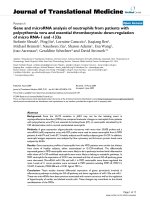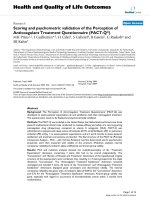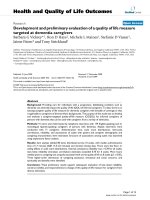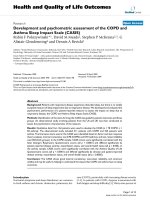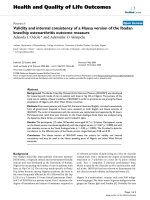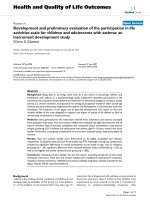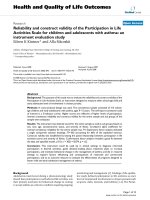báo cáo hóa học:" Adsorption and desorption characteristics of arsenic onto ceria nanoparticles Nanoscale Researc" pptx
Bạn đang xem bản rút gọn của tài liệu. Xem và tải ngay bản đầy đủ của tài liệu tại đây (435.58 KB, 20 trang )
This Provisional PDF corresponds to the article as it appeared upon acceptance. Fully formatted
PDF and full text (HTML) versions will be made available soon.
Adsorption and desorption characteristics of arsenic onto ceria nanoparticles
Nanoscale Research Letters 2012, 7:84 doi:10.1186/1556-276X-7-84
Qinzhong Feng ()
Zhiyong Zhang ()
Yuhui Ma ()
Xiao He ()
Yuliang Zhao ()
Zhifeng Chai ()
ISSN 1556-276X
Article type Nano Express
Submission date 8 August 2011
Acceptance date 23 January 2012
Publication date 23 January 2012
Article URL />This peer-reviewed article was published immediately upon acceptance. It can be downloaded,
printed and distributed freely for any purposes (see copyright notice below).
Articles in Nanoscale Research Letters are listed in PubMed and archived at PubMed Central.
For information about publishing your research in Nanoscale Research Letters go to
/>For information about other SpringerOpen publications go to
Nanoscale Research Letters
© 2012 Feng et al. ; licensee Springer.
This is an open access article distributed under the terms of the Creative Commons Attribution License ( />which permits unrestricted use, distribution, and reproduction in any medium, provided the original work is properly cited.
Adsorption and desorption characteristics of arsenic onto ceria
nanoparticles
Qinzhong Feng
1
, Zhiyong Zhang*
1
, Yuhui Ma
1
, Xiao He
1
, Yuliang Zhao
1
, and Zhifang Chai
1
1
Key Laboratory of Nuclear Analytical Techniques and Key Laboratory for Biomedical
Effects of Nanomaterials and Nanosafety, Institute of High Energy Physics, Chinese
Academy of Sciences, Beijing, 100049, China
*Corresponding author:
Email addresses:
QF:
ZZ:
YM:
XH:
YZ:
ZC:
Abstract
The rapid increase in the use of engineered nanoparticles [ENPs] has resulted in an increasing
concern over the potential impacts of ENPs on the environmental and human health. ENPs
tend to adsorb a large variety of toxic chemicals when they are emitted into the environment,
which may enhance the toxicity of ENPs and/or adsorbed chemicals. The study was aimed to
investigate the adsorption and desorption behaviors of arsenic on ceria NPs in aqueous
solution using batch technique. Results show that the adsorption behavior of arsenic on ceria
NPs was strongly dependent on pH and independent of ionic strength, indicating that the
electrostatic effect on the adsorption of these elements was relatively not important compared
to surface chemical reactions. The adsorption isotherms fitted very well to both the Langmuir
and Freundlich models. The thermodynamic parameters (∆H
0
, ∆S
0
, and ∆G
0
) for the
adsorption of arsenic were determined at three different temperatures of 283, 303, and 323 K.
The adsorption reaction was endothermic, and the process of adsorption was favored at high
temperature. The desorption data showed that desorption hysteresis occurred at the initial
concentration studied. High adsorption capacity of arsenic on ceria NPs suggests that the
synergistic effects of ceria NPs and arsenic on the environmental systems may exist when
they are released into the environment.
Keywords: ceria nanoparticles; arsenic; adsorption; desorption.
Introduction
With the large-scale production and widespread application, the potential environmental risks
of engineered nanoparticles [NPs] have consequently attracted much attention since NPs will
be unavoidably released to the environment after their production, use, and disposal. To date,
the potential environmental effects of NPs, in any quantity, are largely unknown [1-3];
therefore, an understanding of the transport, transfer, and fate of NPs in the environment is an
important issue for evaluating their environmental and health impacts.
NPs usually exhibit remarkable physical properties, rapid chemical reactivity, and high
sorption capacity for inorganic and organic compounds. Studies of the fate and transport of
NPs are largely concerned with how their properties and behavior change over time, whether
they will interact with toxic contaminants after being released into the environment or they
will change the anticipated impact of NPs themselves and the toxic contaminants when they
interact with one another. For example, recent studies showed that phenanthrene could be
adsorbed by iron and copper NPs through hydrophobic effect and dipole interactions between
NPs' charged surface and phenanthrene [4]. Carbon nanotubes [CNTs] tend to adsorb toxic
chemicals of atrazine, and CNTs with adsorbed atrazine exhibited the toxicities of both the
toxic chemicals and CNTs themselves when interacting with living organisms [5]. Therefore,
the potential environmental risks of NPs are exerted not only from the NPs themselves, but
also from the toxic contaminants adsorbed by them [4, 5]. Hence, knowledge of toxic
compound adsorption onto NPs is critical and helpful for their risk assessment, and it is also
useful for understanding the effect of nanomaterials on the fate of toxic compounds in the
environment [4, 5]. Unfortunately, to the best of our knowledge, these studies are limited
within zerovalent metal NPs, CNTs, and related materials [4, 5]; there are no studies that
have examined the adsorption and desorption behaviors of toxic contaminants onto metal
oxide NPs.
Ceria NPs are considered to be a representative member of an industrially important class of
metal oxide NPs [6, 7]; they can be used as automotive catalytic converters [8], UV-blocking
agents [9], and single, nanowire-based gas sensors [10]. Indeed, ceria NPs are on the OECD
list of priority nanomaterials for immediate testing. However, at present, little ecotoxicity
data are available. Previous studies have demonstrated that ceria NPs have toxic effects on
cells [11, 12], aquatic organisms [13, 14], and plants [15]; however, other reports show that
ceria NPs are able to rescue HT22 cells from oxidative stress-induced cell death [16] and
protect against the progression of cardiac dysfunction [17]. These contradictory results
suggest the complex behaviors of ceria NPs in the environment.
Arsenic is one of the most toxic elements and is found virtually in all environmental systems
as a result of both geological processes and anthropogenic activities [18, 19]; the USEPA has
set a maximum contaminant level for arsenic at 10 µg L
−1
in drinking water [20]. Adsorption
with metal oxides has been widely used to remove these contaminants because of its
effectiveness and simplicity for point-of-use applications. However, since the environmental
release of ceria NPs from various applications, the NPs' solid surface interactions with
organic contaminants, such as arsenic, have become increasingly important, and the
subsequent behavior and effects of the released NPs must be considered an urgent need.
Information on the interaction of free and aggregated NPs with adsorbed chemicals is lacking
from the literature, although studies suggest that the adsorption of phenanthrene on nanosized
zerovalent iron and copper significantly decreases with the increase in pH, that naphthalene
exerted significant competition adsorption with phenanthrene [4], and that Th(IV) adsorption
onto oxidized MWCNTs is endothermic [21]. The present work investigated the adsorption
and desorption behaviors of arsenic onto ceria NPs. The objectives include (1) to quantify
and predict the adsorption behavior of arsenic on ceria NPs under different pH and ionic
strength, (2) to determine adsorption isotherms and analyze regressively experimental data
with Langmuir and Freundlich models, (3) to study the adsorption of arsenic at different
temperatures and measure the adsorption thermodynamic parameters (i.e., ∆H
0
, ∆S
0
, ∆G
0
),
and (4) to investigate the desorption behavior of arsenic at the ceria NPs' surface using batch
adsorption experiments.
Experimental details
Materials and methods
All chemicals used were of analytical reagent grade. Milli-Q water (18.2 MΩ cm, Millipore,
Beijing, China) was used for all solution preparation. Stock solutions of arsenic were
purchased from the National Institute of Metrology (Beijing, China). These stock solutions
were kept at 4°C in darkness. Working solutions of arsenic (0.4 to 40.0 µg L
−1
) were prepared
daily by dilution of the stock solution with HCl. Working solutions of 20% (w/v) potassium
tetrahydroborate were prepared daily by dilution of the KBH
4
stock solution in 5% NaOH.
Pre-reducing solutions containing 10% (w/v) thiourea (Beijing Chemical Works, Beijing,
China) and 10% (w/v) ascorbic acid (Sigma, Sigma-Aldrich Corporation, St. Louis, MO,
USA) were prepared fresh daily in water. Glassware used for the determination of arsenic
was soaked in a 10% (v/v) nitric acid solution and rinsed with Milli-Q water.
Preparation and characterization of ceria NPs
Ceria NPs used in the experiments were synthesized using a precipitation method as
described in our former reports [16, 22, 23].The resulting ceria NPs were characterized with a
Tecnai G
2
20 S-Twin transmission electron microscope (FEI Company, Tokyo, Japan)
operated at 200 keV and with dynamic light scattering, using a Coulter Nicomp
TM
380 ZLS
Particle Size Analyzer (Santa Barbara, CA, USA). The surface area was characterized by
nitrogen adsorption/desorption analysis of Brunauer-Emmett-Teller (Autosorb-1,
Quantachrome Instruments, Boynton Beach, FL, USA).
The X-ray diffraction [XRD] patterns for ceria NPs were recorded on an X' Pert PRO
(PANalytical B.V., Almelo, The Netherlands) with monochromatized Cu K
α
radiation. The
particle size of CeO
2
was calculated from the Scherrer formula using the (220) diffraction
peak of the respective cerium oxide [24].
Adsorption experiments
Adsorption isotherms by batch studies were conducted in 7-mL capped centrifuge tubes.
Each tube containing 5-mL varying concentrations of arsenic was mechanically shaken on a
horizontal motion shaker for 24 h (preliminary experiments had shown that all solid-solution
mixtures reached apparent equilibrium within 2 h) at room temperature (25°C).
Thermodynamic parameters associated with the adsorption processes were carried out in
temperatures of 283, 303, and 323 K. After centrifugation (10,000 rpm for 10 min), the
supernatant was sampled and analyzed. The concentration of ceria NPs used for the
adsorption experiments was 5 g L
−1
. Initial concentrations of arsenic were ranged from 0.4 to
40.0 µg L
−1
. All experiments were conducted in triplicate.
The solution pH plays a critical role in the adsorption of metalloid ions onto various
adsorbents. To optimize the pH for maximum removal efficiency, a sorption experiment was
conducted in the initial pH range from 1.0 to 13.0, adjusted using HCl or NaOH.
For ionic strength effect tests, the desired initial sodium nitrate was from 1 × 10
−8
to 1.0 mol
L
−1
, arsenic was added, and the batch equilibration was initiated immediately. The effect of
H
2
SiO
3
colloid and Fe(OH)
3
colloid on As(III) and As(V) adsorptions was examined with the
concentration from 2 × 10
−6
to 0.1 mmol L
−1
and from 1 × 10
−7
to 0.05 mmol L
−1
for H
2
SiO
3
colloid and Fe(OH)
3
colloid, respectively.
Desorption experiments
Desorption experiments of arsenic were carried out in sequential decant-refill steps
immediately following the completion of the sorption experiments. The supernatant (4.0 mL)
was removed and immediately replaced by the same volume of background solution (0.01 M
NaNO
3
), and the vials were resealed and shaken. After 24 h of equilibration, the vials were
centrifuged, arsenic in the supernatant was determined, and the amount of arsenic desorbed
was calculated from mass differences. The above process was repeated for four complete
cycles. All samples were performed at least in triplicate.
Speciation and analysis of arsenic by hydride generation-atomic fluorescence
spectrometry
The AFS-9800 atomic fluorescence spectrometer (Beijing Kechuang Haiguang Instrument
Co., Ltd, Beijing, China) was used for arsenic determination. The arsine was generated by
adding precise, known volumes of the sample, a reducing solution of potassium
tetrahydroborate solution (20%) and hydrochloric acid (10%) using an autosampler. Also, a
pre-reducing solution (thiourea 10% and ascorbic acid 10%) was used to pre-reduce
arsenic(V) to arsenic(III) when the task was to speciate arsenic(III) and arsenic(V).
Arsenic(V) was determined by the difference between total inorganic arsenic and arsenic(III).
Results and discussion
Characterization of ceria NPs
Precipitation method is an attractive, simple, and seemingly general method for producing
high-quality ceria NPs under optimum synthesizing conditions. The average particle diameter
was 6.6 ± 0.9 nm (Figure 1a). BET analysis demonstrated that the ceria NPs had high specific
surface areas which were about 86.85 m
2
g
−1
. The size distribution of the hydrodynamic
diameter of ceria NPs was about 44.8 ± 1.6 nm.
The results of XRD in Figure 1b showed that ceria NPs were a single-phase, cubic, calcium
fluoride-type structure with space group Fm3m, and no evidence was found for the existence
of impurities in the products which was consistent with other reports [25].
Adsorption isotherms
Langmuir and Freundlich isotherms were employed to describe the adsorption of arsenic on
ceria NPs at 283, 303, and 323 K. The equation of the Langmuir isotherm is given as
Equation 1:
e e
e max L max
1
C C
q q K q
= + . (1)
The adsorption capacity q
max
and adsorption constant K
L
can be determined from the slope
and intercept of a linearized plot of C
e
/q
e
against C
e
.
The Freundlich isotherm is derived by assuming a heterogeneous surface with a nonuniform
distribution of the heat of sorption over the surface. It can be expressed as follows:
1/
e f e
n
q K C
= . (2)
The equation can be written as a linearized form:
e f e
ln( ) ln( ) (1/ )1n(C )
q K n= + , (3)
where K
f
and n are the Freundlich constants: n gives an indication of how favorable the
adsorption is, and K
f
(mg/g (L/mg)
1/n
) is the adsorption capacity of the adsorbent. If the value
of 1/n is lower than 1, it indicates a normal Freundlich isotherm; otherwise, it is indicative of
cooperative adsorption. The Freundlich constants can be obtained from the plot of log q
e
versus log C
e
.
Both Freundlich model and Langmuir model were tested for fitting the arsenic adsorption
data. Based on those model equations, the adsorption parameters q
max
, K
L
, K
f
, and n, and the
correlation coefficient values (R) of arsenic onto ceria NPs were obtained (Table 1). As seen
in Table 1, the adsorption of arsenic onto ceria NPs was well fitted to the Langmuir isotherm
model with high R (0.9695 to 0.9815), and this result may be due to the homogeneous
distribution of active sites on the surface of ceria NPs. Furthermore, the values of R
L
for the
Langmuir isotherm were between 0 and 1, and the Freundlich constant 1/n was smaller than 1
(0.43 to 0.66), indicating a favorable process. The high adsorption capacity (q
max
17.08 to
18.05 mg g
−1
) in the present work reveals that the combination of ceria NPs and arsenic may
be efficacious on the environment. The adsorption of arsenic (q
max
and K
f
in the Langmuir
model and the Freundlich model, respectively) increased with the rise in temperature,
illuminating an endothermic process for arsenic adsorption onto ceria NPs. The adsorption
isotherm was higher at 323 K than the other two isotherms, whereas the adsorption isotherm
at 283 K was the lowest. The results indicated that the adsorption of arsenic onto ceria NPs
was favored at high temperature and was blocked at low temperature.
Thermodynamic parameters associated with the adsorption processes
The thermodynamic adsorption parameters can be calculated from the variation of the
thermodynamic equilibrium constant K
0
under different temperatures. The standard molar
free energy of adsorption [∆G
0
] is calculated from the relationship:
0
0
RT ln
G K
∆ = − . (4)
The average standard enthalpy [∆H
0
] is obtained from the slope of the linear variation of lnK
0
versus 1/T.
0
0
ln constant
RT
H
K
∆
= − + . (5)
The standard entropy [∆S
0
] is calculated from:
0 0 0
( ) /
S H G T
∆ = ∆ − ∆ . (6)
The thermodynamic adsorption parameter values obtained were given in Table 2. The
adsorption enthalpy of arsenic onto ceria NPs was 17.89 kJ mol
−1
, indicating that the
adsorption process of arsenic onto ceria NPs was endothermic. It was reported that the
enthalpy of physisorption was smaller than 20 kJ mol
−1
[22]. Based on the above ∆H
0
, it
suggests that the adsorption of arsenic onto ceria NPs is a physisorption process. The positive
adsorption entropy indicated that the degrees of freedom increased at the solid-liquid
interface during the adsorption of arsenic onto ceria NPs. ∆G
0
values were in the range of
−1.40 to −4.18 kJ mol
−1
when the adsorption temperature was from 283 to 323 K, and the
negative values of ∆G
0
indicated that the adsorption process was spontaneous. The
thermodynamic adsorption data indicated that the adsorption of arsenic onto ceria NPs was an
endothermic process, and the process was favorable at high temperature. The results were
consistent with the adsorption isotherm results.
Adsorption and desorption
Figure 2 shows the adsorption and desorption isotherms of arsenic on ceria NPs. There would
be a corresponding concentration-dependent effect in this study: the desorption of ceria NPs
had no significant desorption hysteresis for 20 µg L
−1
of arsenic, while it had significant
desorption hysteresis when the initial concentration of arsenic was 80 µg L
−1
with the
thermodynamic index of irreversibility ranging from 0.58 to 0.95.
Hysteresis is referred to as irreversible adsorption which is reproducible and originates from a
shift in the equilibrium point when a reaction approaches equilibrium from desorption
direction rather than sorption [4, 26, 27]. Similar result was reported by Shirvani et al. that
the quantity of Cd desorbed from the minerals after five cycles of desorption was depending
on the initial load of Cd on the minerals [26]. Recent studies supported irreversible
deformation as the cause of hysteresis in flexible solids, such as natural organic matter and
organoclays [5, 27]. During the adsorption-desorption cycle, pore deformation may result in
some of adsorbent transferred to sites in the solid where free exchange with molecules in the
bulk fluid phase is no longer possible.
Desorption of inorganic and organic contaminants from the adsorbent is rapidly gaining
recognition owing to its importance to the fate, toxicity, and transport of these contaminants
in the environmental system. If the contaminants would be released from the adsorbent in
significant concentrations, either in the environmental or biotic mediums, they would be a
risk for living organisms. In this work, high adsorption capacity and reversible adsorption of
arsenic on ceria NPs suggest that ceria NPs may influence the fate and behavior of arsenic in
the environment. Thus, ceria NPs with arsenic may exhibit synergistic effects when
interacting with living organisms.
Adsorption characteristics of arsenic(III) and arsenic(V) in different environmental
conditions
Inorganic arsenic has four oxidation states: +5, +3, 0, and −3. In the soil/water environment,
it is mainly present in the +3 and +5 oxidation states. In reduced environments, arsenious acid
is a common arsenic(III) aqueous species, whereas oxidized environments contain more
arsenic(V) aqueous species. These two aqueous species may adsorb onto inorganic and
organic components and precipitate in a variety of forms. The environmental fate of arsenic
in subsurface environments is highly dependent on the arsenic speciation, pH, ionic strength,
and the presence of adsorbents such as metal oxides. Furthermore, there are many kinds of
colloidal solutions with different charges in water, for example, in general, H
2
SiO
3
colloid
surface has a negative charge and Fe(OH)
3
colloid surface has a positive charge, which may
affect the adsorption of arsenic on ceria NPs. However, little investigation had been
conducted on the adsorption of arsenic by ceria NPs in different colloidal solutions. The
experiments below were carried out to investigate the adsorption characteristic of arsenic
onto ceria NPs in different environmental conditions.
Both arsenate and arsenite adsorptions on ceria NPs as a function of solution pH exhibited a
parabolic adsorption curve which was showed in Figure 3. Adsorption increased with
increasing solution pH from pH 1 to 6 and then decreased with increasing pH from pH 6 to
13 for arsenate, which was similar to the report that arsenate adsorption on the clays
increased with increasing solution pH from pH 3 to 5 and decreased with increasing solution
pH from pH 5 to 9 [28]. As for arsenite, adsorption increased with increasing solution pH
from pH 1 to 8 (the maximum adsorption was 70%) and then decreased with increasing pH
from pH 8 to 13; a similar behavior was found for arsenite adsorption on the clays and
amorphous Al oxide [28]. The maximum adsorption of arsenite occurs in the weak alkaline
region, up to pH 10; OH
−
competition for the arsenite centers at high pH values which leads
to the decreasing adsorption.
From Figure 3, it could also be found that arsenite is commonly more strongly adsorbed on
ceria NPs than arsenate especially when pH was above 9. Theoretically, arsenate is
commonly more strongly adsorbed on ceria NPs than arsenite since arsenate presents as
H
2
AsO
4
−
and HAsO
4
2−
when pH is from 2 to 8, while arsenite presents as As(OH)
3
0
species.
Some reports showed that at all pH values, arsenic(V) was more strongly bound than
arsenic(III) [28-30]. Thus, further experiments in our future study should be carried out to
study the adsorption mechanism.
The effects of ionic strength on the adsorption of arsenic(III) and arsenic(V) onto the surfaces
of ceria NPs were presented in Figure 4. The amount of arsenic(III) and arsenic(V) adsorbed
by ceria NPs was stable with increasing ionic strength from 1 × 10
−8
to 1.0 mol L
−1
NaNO
3
.
Therefore, ionic strength generally had very minor or no impact on the adsorption in this
study. Similar results were also observed by other reports when iron oxide or other sorbents
were used [31-35].
The ionic strength can influence the double-layer thickness and interface potential; thereby, it
can affect the binding of the sorbed species [36, 37]. The specific and nonspecific adsorptions
can be distinguished by evaluating the effect of ionic strength on anion partitioning [37]. It
was reported that the specific adsorption is unaffected by the change in ionic strength,
whereas the nonspecific adsorption is likely to be influenced greatly by the change of ionic
strength because of the competitive adsorption with counteractions. The insignificant impact
of ionic strength indicated that the specific adsorption was found on the adsorption of
arsenic(V) and arsenic(III) by ceria NPs which resulted from an inner sphere complex
formation between arsenic and the surface of ceria NPs. The strong pH dependence and ionic
strength independence further indicate that the adsorption mechanism is mainly surface
complexation rather than ion exchange.
H
2
SiO
3
colloid was homemade with the particle size of 50 nm. Figure 5 reveals that arsenic
adsorption on ceria NPs increased significantly with the increasing of H
2
SiO
3
colloid
concentration from 2 × 10
−6
to 1 × 10
−5
mmol L
−1
, while it was stable when H
2
SiO
3
colloid
concentration was from 2 × 10
−4
to 0.1 mmol L
−1
. Meanwhile, ceria NPs had lower
adsorption capacity for As(III) than for As(V) with the existence of H
2
SiO
3
colloidal solution.
The possible reason may be the different pH in these solutions. When the concentrations of
H
2
SiO
3
colloidal solution were lower than 0.001 mol L
−1
, the pH values were from 5.35 to
5.91. Acid dissociation [pK
a
] values for arsenious acid are as follows: pK
a
1
= 9.2 and pK
a
2
=
12.1, while pKa values for arsenic acid are pK
a
1
= 2.3, pK
a
2
= 6.8, and pK
a
3
= 11.6. Therefore,
at pH 5.35 to 5.91, the surface has a net positive charge; As(III) exists in neutral H
3
AsO
3
0
which has less influence than the adsorption for negatively charged As(V) species which
exists in H
2
AsO
4
−
. The inflections or maxima in the adsorption of arsenic at pH values close
to their pK
a
values are a well-documented phenomenon [38, 39].
Fe(OH)
3
colloidal solution was synthesized in our laboratory, and TEM showed that Fe(OH)
3
particle was a nanorod with 30 to 70 nm in long diameter. NPs with a high specific surface
area tend to adsorb a large variety of toxic chemicals, which may enhance the toxicity of
toxic chemicals. It was found from Figure 6 that arsenic adsorption on ceria NPs increased
stably with the increasing of H
2
SiO
3
colloid concentration from 1 × 10
−7
to 0.05 mmol L
−1
;
furthermore, ceria NPs had lower As(III) adsorption than As(V) adsorption under these
conditions. Such a difference in As(III) and As(V) sorption efficiencies on ceria NPs could be
related to possible differences between arsenic surface complexes on these different
absorbents. Interestingly, a recent study by Wang et al. [40] proposed that arsenate is
absorbed more efficiently than arsenite on green rusts: for arsenate, the presence of binuclear
bidentate double-corner complexes and mononuclear monodentate corner-sharing complexes
at the surface of green rusts, and for arsenite, the presence of dimers of As(III) pyramids
binding to the edges of the GR1Cl layers by corner sharing with FeO
6
octahedra. On the other
hand, Raven et al. [39] observed that arsenite adsorption was higher than arsenate adsorption
on ferrihydrite throughout the pH range of 3 to 11. These findings indicate that different
ferrous-based compounds have different adsorption capacities for arsenic, which in turn
complicates the adsorption behavior of arsenic in ceria NPs.
Conclusions
The high adsorption capacity and reversible adsorption of arsenic on ceria NPs clearly
confirm that ceria NPs can interact with arsenic when they are released into the environment,
which may influence the fate and behavior of arsenic and may enhance the toxicity of ENPs
and/or arsenic. Taken together, the results indicate that studies dealing with the potential
ecotoxicological effects of NPs for the environment have to be designed carefully in order to
have the defined understanding between the NPs and the adsorbed chemicals in the
environment.
Competing interests
The authors declare that they have no competing interests.
Authors' contributions
QF designed the study, performed the research, and prepared the manuscript. ZZ provided the
experimental idea and advised the experimental design. YM synthesized the target material
and performed the statistical analysis. XH participated in the adsorption experiments. YZ and
ZC contributed to the experimental idea and drafted the manuscript. All authors read and
approved the final manuscript.
Acknowledgments
This work is financially supported by the Ministry of Science and Technology of China (grant
no. 2011CB933400), the Ministry of Environmental Protection of China (grant no.
201209012), the National Natural Science Foundation of China (grant nos. 10875136 and
10905062), and the China Postdoctoral Science Foundation (grant nos. 20090460520 and
201003155).
References
1 Stephen JK, Pedro JJ, Graeme EB, Teresa FF, Richard DH, Delina YL, Shaily M, Michael
JM, Jamie RL: Nanomaterials in the environment: behavior, fate, bioavailability, and
effects. Environ Toxicol Chem 2008, 27:1825-2851.
2 Grazyna B, Jerzy G, Pawel LU: Nanoparticles: their potential toxicity, waste and
environmental management. Waste Manage 2009, 29:2587-2595.
3 Moore MN: Do nanoparticles present ecotoxicological risks for the health of the
aquatic environment? Environ Int 2006, 32:967-976.
4 Fang J, Shan XQ, Wen B, Lin JM, Lu XC, Liu XD, Owens G: Sorption and desorption of
phenanthrene onto iron, copper, and silicon dioxide nanoparticles. Langmuir 2008,
24:10929-10935.
5 Yan XM, Shi BY, Lu JJ, Feng CH, Wang DS, Tang HX: Adsorption and desorption of
atrazine on carbon nanotubes. J Colloid Interf Sci 2008, 321:30-38.
6 Birbaum K, Brogioli R, Schellenberg M, Martinoia E, Stark WJ, Günther D, Limbach LK:
No evidence for cerium dioxide nanoparticle translocation in maize plants. Environ
Sci Technol 2010, 44:8718-8723.
7 Ludwig KL, Robert B, Elisabeth M, Rolf K, René G, Wendelin JS: Removal of oxide
nanoparticles in a model wastewater treatment plant: influence of agglomeration and
surfactants on clearing efficiency. Environ Sci Technol. 2008, 42:5828-5833.
8 Chen JP, Patil S, Seal S, Mcginnis JF, Rare earth nanoparticles prevent retinal
degeneration induced by intracellular peroxides, nature nanotechnology. Nature
Nanotechnology 2006, 1:142-150.
9 Zholobak NM, Ivanov VK, Shcherbakov AB, Shaporev AS, Polezhaeva OS, Baranchikov
AY, Spivak NY, Tretyakov YD: UV-shielding property, photocatalytic activity and
photocytotoxicity of ceria colloid solutions. J Photoch Photobio B 2010, 102:32-38.
10 Yuan Q, Duan HH, Li LL, Sun LD, Zhang YW, Yan CH: Controlled synthesis and
assembly of ceria-based nanomaterials. J Colloid Interf Sci 2009, 335:151-167.
11 Thill A, Zeyons O, Spalla O, Chauvat F, Rose J, Auffan M, Flank AM: Cytotoxicity of
CeO2 nanoparticles for Escherichia coli. Physico-chemical insight of the cytotoxicity
mechanism. Environ Sci Technol 2006, 40:6151-6156.
12 Safi M, Sarrouj H, Sandre O, Mignet N, Berret JF: Interactions between sub-10-nm iron
and cerium oxide nanoparticles and 3T3 fibroblasts: the role of the coating and
aggregation state. Nanotechnology 2010, 21:145103.
13 Hoecke KV, Quik JT, Mankiewicz-Boczek J, Schamphelaere KA, Elsaesser A, Meeren PV,
Barnes C, McKerr G, Howard VC, Meent DV, Rydzyński K, Dawson KA, Salvati A,
Lesniak A, Lynch I, Silversmit G, Samber BD, Vincze L, Janssen CR: Fate and effects of
CeO
2
nanoparticles in aquatic ecotoxicity tests. Environ Sci Technol 2009,
43:4537-4546.
14 Johnston BD, Scown TM, Moger J, Cumberland SA, Baalousha M, Linge K, Aerle R,
Jarvis K, Lead JR, Tyler CR: Bioavailability of nanoscale metal oxides TiO
2
, CeO
2
,
and ZnO to fish. Environ Sci Technol 2010, 44:1144-1151.
15 López-Moreno ML, Rosa G, Hernández-Viezcas J, Castillo-Michel H, Botez CE,
Peralta-Videa JR, Gardea-Torresdey JL: Evidence of the differential biotransformation
and genotoxicity of ZnO and CeO
2
nanoparticles on soybean (Glycine max) plants.
Environ Sci Technol 2010, 44:7315-7320.
16 Lu K, Zhang ZY, He X, Ma YH, Zhou KB, Zhang HF, Bai W, Ding YY, Wu ZQ, Zhao
YL, Chai ZF: Bioavailability and distribution of ceria nanoparticles in simulated
aquatic ecosystems, quantification with a radiotracer technique. J Nanosci
Nanotechno 2010, 10:8658-8662.
17 Niu JL, Asim A, Linda MR, Wang XH, Pappachan EK: Cardioprotective effects of
cerium oxide nanoparticles in a transgenic murine model of cardiomyopathy.
Cardiovasc Res 2007, 73:549-559.
18 Huang JH, Ilgen G, Vogel D, Michalzik B, Hantsch S, Tennhardt L, Bilitewski B:
Emissions of inorganic and organic arsenic compounds via the leachate pathway
from pretreated municipal waste materials: a landfill reactor study. Environ Sci
Technol 2009, 43:7092-7097.
19 Williams PN, Lei M, Sun GX, Huang Q, Lu Y, Deacon C, Meharg AA, Zhu YG:
Occurrence and partitioning of cadmium, arsenic and lead in mine impacted paddy
rice: Hunan, China. Environ Sci Technol 2009, 43:637-642.
20 Arai Y, Lanzirotti A, Sutton S, Davis JA, Sparks DL: Arsenic speciation and reactivity
in poultry litter. Environ Sci Technol 2003, 37:4083-4090.
21 Chen CL, Li XL, Zhao DL, Tan XL, Wang XK: Adsorption kinetic, thermodynamic
and desorption studies of Th(IV) on oxidized multi-wall carbon nanotubes. Colloids
Surface A 2007, 302:449-454.
22 Zhang F, Jin Q, Chan SW: Ceria nanoparticles: size, size distribution, and shape. J
Appl Phys 2004, 95:4319-4325.
23 Ma YH, Kuang LL, He X, Bai W, Ding YY, Zhang ZY, Zhao YL, Chai ZF: Effects of rare
earth oxide nanoparticles on root elongation of plants. Chemosphere 2010,
78:273-279.
24 Zhang J, Ju X, Wu ZY, Liu T, Hu TD, Xie YN: Structural characteristics of cerium
oxide nanocrystals prepared by the microemulsion method. Chem Mater 2001,
13:4192-4197.
25 Rane N, Zou H, Buelna G, Lin JYS: Sol-gel synthesis and properties of unsupported
and supported mesoporous ceria membranes. J Membrane Sci 2005, 256:89-97.
26 Shirvani M, Kalbasi M, Shariatmadari H, Nourbakhsh F, Najafi B: Sorption–desorption
of cadmium in aqueous palygorskite, sepiolite, and calcite suspensions: isotherm
hysteresis. Chemosphere 2006, 65:2178-2184.
27 Sander M, Lu YF, Pignatello JJ: A thermodynamically based method to quantify true
sorption hysteresis. J Environ Qual 2005, 34:1063-1072.
28 Goldberg S: Competitive adsorption of arsenate and arsenite on oxides and clay
minerals sabine goldberg. Soil Sci Soc Am J 2002, 66:413-421.
29 Chakraborty S, Wolthers M, Chatterjee D, Charlet L: Adsorption of arsenite and
arsenate onto muscovite and biotite mica. J Colloid Interf Sci 2007, 309:392-401.
30 Buschmann J, Kappeler A, Lindauer U, Kistler D, Berg M, Sigg L: Arsenite and
arsenate binding to dissolved humic acids: influence of pH, type of humic acid, and
aluminum. Environ Sci Technol 2006, 40:6015-6020.
31 Antelo J, Avena M, Fiol S, López R, Arce F: Effects of pH and ionic strength on the
adsorption of phosphate and arsenate at the goethite–water interface. J Colloid Interf
Sci 2005, 285:476-486.
32 Vithanage M, Chandrajith R, Bandara A, Weerasooriya R: Mechanistic modeling of
arsenic retention on natural red earth in simulated environmental systems. J Colloid
Interf Sci 2006, 294:265-272.
33 Arai Y, Elzinga EJ, Sparks DL: X-ray absorption spectroscopic investigation of
arsenite and arsenate adsorption at the aluminum oxide–water interface. J Colloid
Interf Sci 2001, 235:80-88.
34 Catalano JG, Zhang Z, Fenter P, Bedzyk MJ: Inner-sphere adsorption geometry of
Se(IV) at the hematite (100)-water interface. J Colloid Interf Sci 2006, 297:665-671.
35 Su TZ, Guan XH, Gu GW, Wang JM: Adsorption characteristics of As(V), Se(IV), and
V(V) onto activated alumina: effects of pH, surface loading, and ionic strength. J
Colloid Interf Sci 2008, 326:347-353.
36 Chen CL, Wang XK: Sorption of Th (IV) to silica as a function of pH, humic/fulvic
acid, ionic strength, electrolyte type. Appl Radiat Isotopes 2007, 65:155-163.
37 Xu RK, Wang Y, Tiwari D, Wang HY: Effect of ionic strength on adsorption of As(III)
and As(V) on variable charge soils. J Environ Sci 2009, 21:927-932.
38 Altundoğan HS, Altundoğan S, Tümen F, Bildik M: Arsenic adsorption from aqueous
solutions by activated red mud. Waste Manage 2002, 22:357-363.
39 Raven K, Jain A, Loeppert R: Arsenite and arsenate adsorption on ferrihydrite:
kinetics, equilibrium, and adsorption envelopes. Environ Sci Technol 1998,
32:344-349.
40 Wang YH, Morin G, Ona-Nguema G, Juillot F, Guyot F, Calas G, Brown GE: Evidence
for different surface speciation of arsenite and arsenate on green rust: an EXAFS
and XANES Study. Environ Sci Technol 2010, 44:109-115.
Figure 1. Characterization of ceria NPs. (a) TEM image of ceria NPs prepared in the
present study. (b) XRD patterns of ceria NPs powders.
Figure 2. Adsorption and desorption isotherms of arsenic on ceria NPs. Filled square,
adsorption data; filled triangle, 80 µg L
−1
of initial arsenic with desorption; empty inverted
triangle, 20 µg L
−1
of initial arsenic with desorption; T = 298 K.
Figure 3. Effect of pH on the adsorption of As(III) and As(V) on ceria NPs. C
initial arsenic
=
80 µg L
−1
, I = 0.01 mol L
−1
NaNO
3
, T = 298 K.
Figure 4. Effect of ion strength on the adsorption of As(III) and As(V) on ceria NPs.
C
initial arsenic
= 80 µg L
−1
, T = 298 K.
Figure 5. Effect of H
2
SiO
3
colloid on the adsorption of As(III) and As(V) on ceria NPs.
C
initial arsenic
= 80 µg L
−1
, T = 298 K.
Figure 6. Effect of Fe(OH)
3
colloid on the adsorption of As(III) and As(V) on ceria NPs.
C
initial arsenic
= 80 µg L
−1
, T = 298 K.
Table 1. Isotherm model constants of three isotherm models for arsenic adsorption onto
ceria NPs
Temperature (K) Model Parameters
283 303 323
q
max
(mg g
−1
) 17.08 18.02 18.15
K
L
(L mg
−1
) 0.063 0.066 0.24
Langmuir model
R 0.9695 0.9704 0.9815
K
f
(mg g
−1
) (L mg
−1
)
1/n
1.32 1.40 2.32
n 1.54 1.52 1.77
Freundlich model
R 0.9957 0.9948 0.9966
q
max
, adsorption capacity; K
L
, adsorption constant; K
f
and n, Freundlich constants; R,
correlation coeeficient.
Table 2. Thermodynamic parameters for arsenic adsorption onto ceria NPs
Thermodynamic parameters Temperature (K)
ln(K
0
) ∆G
0
(kJ mol
−1
) ∆H
0
(kJ mol
−1
) ∆S
0
(J mol
−1
K
−1
)
283 0.59 −1.40 17.89 71.52
303 0.65 −1.65 17.89 70.51
323 1.56 −4.18 17.89 80.78
∆G
0
, standard molar free energy of adsorption; ∆H
0
, average standard enthalpy; ∆S
0
, standard
entropy.
20 30 40 50 60 70 80 90
0
500
1000
1500
2000
(420)
(422)
(331)
(400)
(222)
(311)
(220)
(200)
Relative intensity (A.U.)
2 Theta (degree)
(111)
a
b
a
Figure 1
0 10 20 30 40 50 60
0
4
8
12
16
20
A
dsorbed As (mg g
-1
)
C
oncentration of aqueous As (g L
-1
)
Desorption
Adsorption
Figure 2
0
10
20
30
40
50
60
70
Adsorbed As %
pH
As (V)
As (III)
1.0 2.0 4.0 6.0 8.0 10.0 12.0 13.0
Figure 3
0
10
20
30
40
50
60
70
Adsorbed As %
Concentration of NaNO
3
(mol L
-1
)
As (V)
As (III)
1.0 0.1 0.01 1*10
-3
1*10
-4
1*10
-5
1*10
-6
1*10
-8
Figure 4
0
20
40
60
80
Adsorbed As %
Concentration of H
2
SiO
3
(mmol L
-1
)
As (V)
As (III)
Figure 5
0
10
20
30
40
50
60
70
80
Adsorbed As %
Concentration of Fe(OH)
3
(mmol L
-1
)
As (V)
As (III)
Figure 6
